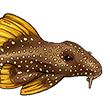https://www.scielo.br/j/gmb/a/HdYjxbcTSrfpPL4QSVBwdJL/
Keywords: Auchenipteridae cytogenetics; heteromorphic sex chromosomes; interstitial telomeric sequence; repetitive DNA mapping.Abstract has the lowest diploid chromosome number (2n = 46) and the only described heteromorphic sex chromosome system in Auchenipteridae. This study presents a population of C. heckelii from the Central Amazon basin with subtle variations in the karyotype composition and a variant W chromosome with distinct morphology and increased C-positive heterochromatin content. In this population, the W chromosome is subtelocentric, whereas the only previous study on C. heckelii reported a metacentric W chromosome. Constitutive heterochromatin (CH) and accumulation of microsatellite motifs have significantly contributed to this W chromosome enlargement. Notably, this population exhibits numerous interstitial telomeric sites (ITSs). Some of these ITSs might represent genuine chromosomal fusion points due to the reduced 2n; however, additional mechanisms, such as chromosomal inversions, translocations, transpositions, or association with satellite DNA, are likely responsible for this unusual pattern. The 18S rDNA sites were found in both the Z and W chromosomes of all individuals. However, two individuals exhibited an additional 18S rDNA site in a single homologous of the chromosome pair 20, characterizing an intrapopulation polymorphism. The 5S rDNA sites were found in two chromosome pairs, distinguishing this population from other Centromochlinae species and further supporting it as one of the most efficient cytotaxonomic markers within the subfamily.





